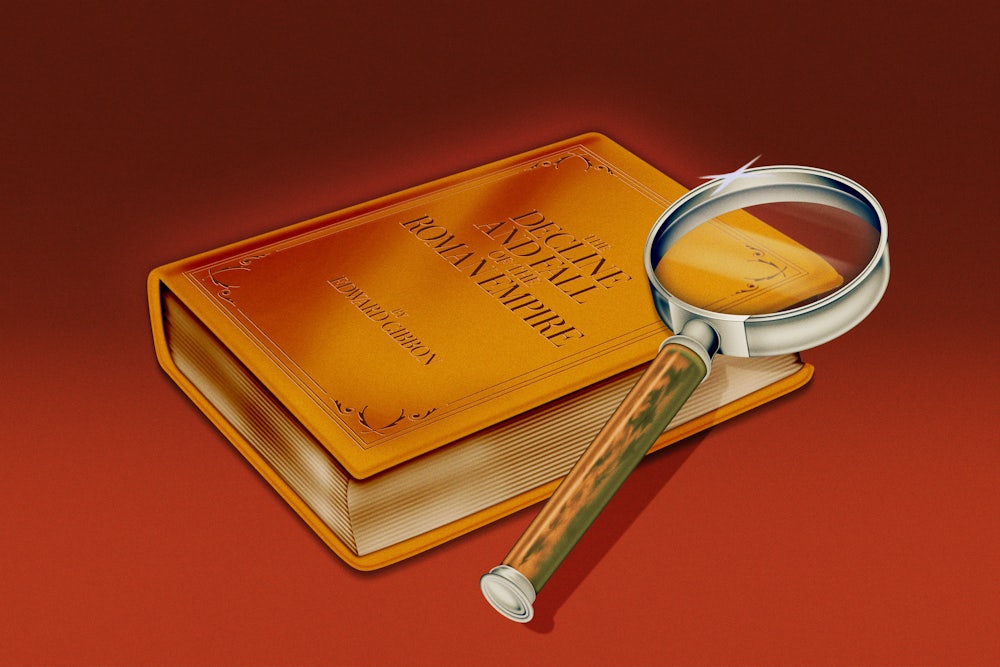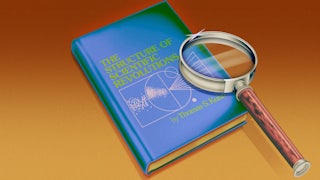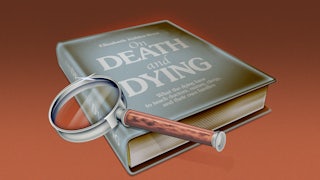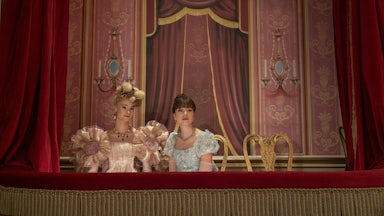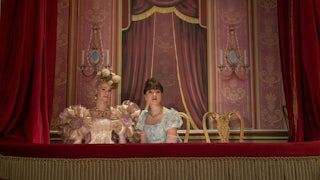There is an old joke. A student at Oxford attends a cocktail party with members of the faculty. Hoping to impress these august dons, the student casually mentions, “I was reading Gibbon the other night …” Later, the student’s faculty mentor pulls him aside to chide him for the comment. “One must never say one is reading Gibbon,” he says. “One must always say one is re-reading Gibbon.”
There is a good case to be made that Edward Gibbon’s Decline and Fall of the Roman Empire is the single most famous work of history ever written in the English language. Published in the auspicious year of 1776, Gibbon’s first volume of Decline and Fall landed to instant success and acclaim. Its first print run sold out, necessitating an immediate second printing. It has been in continuous print ever since. The success of the books made Gibbon a literary and intellectual celebrity in his own time and landed Decline and Fall on the syllabus of every university in the English-speaking world. Well into the twentieth century, Gibbon was regarded as the authority on the Roman Empire. To be educated was to have read Gibbon.
But while the impact and influence of Decline and Fall is almost impossible to overstate, we are not here to prove Gibbon wrote a uniquely significant work of history. He obviously did. We are here to ask whether Decline and Fall holds up. Is this a work that still deserves the power of authority it immediately wielded? Does it command attention and respect from the foremost practitioners of the historical discipline today? Should parents and teachers consider it a reliable guide to the Roman world to assign students in the twenty-first century? The short answer to all three of these questions is … no. Absolutely not. On all three counts.
But before we single out Gibbon for skewering, we must first remember that no work written in the late eighteenth century in nearly any academic discipline holds up to modern scrutiny. Here in the twenty-first century, our corpus of knowledge is vastly superior to that in Gibbon’s time. Of course it is. We simply have more information, better sources, and superior analytic skills. So even cursory scrutiny of Decline and Fall reveals factual inaccuracies, distorted analysis, and polemical rhetoric that disqualify it from being considered an authoritative history of Rome in comparison to any work about Rome written by an expert in the field in the twenty-first century. That does not mean it’s worthless. It just means there are lots of other, better, books to read first.
Let’s start with the title: The History of the Decline and Fall of the Roman Empire. Right away we have problems. Contemporary historians have challenged and overthrown the entire framework of “the fall of Rome.” We understand now that while a slow-moving social and cultural transformation took place, the idea of a sudden visible collapse of civilization is not supported by the record. Nor is it true that the societies that sprang up after Roman rule were ignorant black holes lacking education and culture. Gibbon bears a measure of responsibility for formulating and promulgating the Enlightenment idea that humanity entered what Gibbon called “the rubbish of the dark age” after the fall of Rome.
Gibbon’s central thesis emerges from this flawed framework. An Enlightenment critic of Christianity, Gibbon naturally saw the Church as the principal author of the Dark Ages. Decline and Fall spends much time tracing the rise of Christianity and its spread through the Mediterranean, and how its adoption as state religion fatally undermined the ancient virtues that brought the Romans to their hegemonic heights. None of this holds up. Today, no serious scholar of Rome believes that Christianity played such a central role in the Empire’s decline—not least for the reason that the Eastern Roman Empire, orthodox Christian to its core, persisted for another thousand years after the fall of the Western Empire.
One way to rescue Decline and Fall is to repeat the pithy pronouncement that one may argue with Gibbon’s interpretations but not his facts. His thesis might be wrong, but his facts are solid as oak. But this, unfortunately, is not true either.
It is not hard to understand why Gibbon might still be regarded as a reliable factual authority more than two centuries after his death. It is the same reason his work had such a massive impact in the first place. Decline and Fall is a legitimately groundbreaking work of professional history as we understand it today. Not content to simply synthesize what he read and produce an uninterrupted narrative, Gibbon visibly showed his work, with footnotes that cited his sources, commented on their veracity, and invited the reader to follow not just the story but how he constructed the story. In 1779, he wrote, “The Writer who aspires to the name of Historian, is obliged to consult a variety of original testimonies, each of which, taken separately, is perhaps imperfect and partial.” It was the historian’s job to weigh and measure these sources, but “nothing ought to be inserted which is not proved by some of the witnesses.” The insistence on footnotes and citations is so obvious today that scholars would find it inconceivable not to write as Gibbon does. It is a major part of why he can claim with some legitimacy the title of first modern historian.
But this very openness about his sourcing is often what allows us to see where his story is flawed, misguided, or outright incorrect. Gibbon makes a large and fatal error in relying on a collection of imperial biographies collectively dubbed the Historia Augusta. The collection purports to be written by six different authors, who provide a wealth of information and detail about chaotic periods with otherwise scant and fragmentary sources. Though he deploys his critical eye to describe one of these volumes as the work of a “wretched biographer,” Gibbon nonetheless uses the Historia Augusta to flesh out his story and provide colorful backstories for his characters. But in the late nineteenth century, German historian Hermann Dessau broke critical ground by arguing the Historia Augusta was not written by six different authors over many years but was in fact the work of a single anonymous hoaxster writing in the late fourth century. Though many basic facts in the Historia Augusta can be independently verified, the exquisite details it contains must be read as unreliable historical fiction. Any passage in Decline and Fall found perched atop footnotes citing the Historia Augusta—and there are many—cannot be taken at face value. This is not to say that Decline and Fall is uniformly inaccurate or completely unreliable. Just that there are enough basic factual problems to give pause.
Problems of both interpretation and fact combine in Gibbon’s ethnographic depictions of various groups of people. Gibbon is a disaster on matters of cultural anthropology. Writing from his position as a European acolyte of the Enlightenment, his descriptions and characterizations are replete with various bigotries. Of the nomadic peoples of the Eurasian steppe, Gibbon says their unwillingness to settle into civilized agriculture boils down to “indolence.” He says, “The only example of their industry seems to consist in the art of extracting from mare’s milk a fermented liquor, which possesses a very strong power of intoxication.” Of the Tatars he writes that “they are an ugly and even deformed race; And, while they consider their own women as the instruments of domestic labor, their desires, or rather their appetites, are directed to the enjoyment of more elegant beauty.” Which is to say they fought wars to get hotter women. He assigns to the Jews a “narrow and unsocial spirit” and calls them “a race of fanatics, whose dire and credulous superstition seemed to render them the implacable enemies not only of the Roman government, but also of mankind.”
Gibbon also habitually writes with misogynistic undertones—that the decline of Rome was the story of manly virtues falling into effeminate vices. In a passage explaining the decline in military prowess, he says that “the effeminate luxury which infected the manners of courts and cities had instilled a secret and destructive poison into the camps of the legion.” When describing the Gothic sacking of Rome, Gibbon writes that Alaric encouraged his men “to enrich themselves with the spoils of a wealthy and effeminate people.” Clearly Gibbon saw something damning about anything feminine-coded. Of the Empress Julia Domna, Gibbon writes that “she possessed, even in an advanced age, the attractions of beauty, and united to a lively imagination a firmness of mind, and strength of judgment, seldom bestowed on her sex.” Even in paying a woman a compliment, he can’t escape his attitude.
The ignorant portrayals of other peoples and the casual misogyny combine when Gibbon turns his attention to Eastern “oriental” peoples who are naturally slavish of mind, habituated for despotism, and deeply unmanly to boot. The luxury, effeminacy, and degraded morality of Eastern societies is always depicted as equivalent to a virus infiltrating the Roman Empire. Gibbon writes of the notorious emperor Elagabalus: “The grave senators confessed with a sigh, that, after having long experienced the stern tyranny of their own countrymen, Rome was at length humbled beneath the effeminate luxury of oriental despotism.” These stereotypes pop up routinely, undermining the book’s authority because Gibbon’s premises and conclusions are so obviously distorted by inaccurate portrayals of the peoples he purports to understand.
Does this mean we should chuck Decline and Fall into the dustbin of history? No. Decline and Fall may be most valuable for what it tells us about Gibbon’s times and his purpose in writing it. Gibbon is an unabashed partisan of the Enlightenment, and Decline and Fall was a highly charged text in the social, political, and religious discourse of his era. His broadsides against Christianity may fail as historical argument, but as British historian David Wootton has put it, “It suddenly becomes clear that Gibbon was not simply producing a survey of arguments that might have been used against Christianity in the first century. He was quite systematically trying to provide a survey of eighteenth-century arguments against Christianity.” Decline and Fall may not hold up as a history of Rome, but it is certainly valuable as a confession of the Enlightenment mind.
Gibbon is also a phenomenal prose stylist. On a craft level, his sentences are sparkling, witty, observant, insightful, and very near flawless. There is a reason he has been permanently in print for nearly 250 years. The man can turn a phrase. Even if Gibbon were forever exiled from the history department, we would still be left with a monumental work of literature worthy of study by the English department. On the intersection of religion and politics, he writes: “The various modes of worship which prevailed in the Roman world, were all considered by the people as equally true; by the philosopher, equally false; and by the magistrate, as equally useful.” On the Emperor Caracalla, he says that “his rash ambition had climbed a height where it was difficult to stand with firmness, and impossible to fall without instant destruction.” What turns of phrase! Of Justinian’s patched-together legal code, he artfully says: “Instead of a statue cast in a simple mold by the hand of an artist, the works of Justinian represent a tessellated pavement of antique and costly, but too often of incoherent, fragments.” Of the phenomenon of elite opulence in a time of decline, Gibbon writes that “the mad prodigality which prevails in the confusion of a shipwreck or siege may serve to explain the progress of luxury amidst the misfortunes and terrors of a sinking nation.” Even if not a single word were true, Gibbon’s prose would still be worth reading, just for the joy of reading.
Finally, Gibbon’s work sits comfortably on a chronological continuum of imperfect Roman historians from Polybius to Sallust to Livy to Tacitus to Plutarch to Ammianus Marcellinus to Zosimus to Zonaras. When we read any of these authors to glean insight into Rome, we always start by placing them in their proper times, places, and purposes. The same is true of those who followed Gibbon on this continuum, like Theodore Mommsen in the nineteenth century, Ronald Syme in the twentieth century, or Mary Beard in the twenty-first century. We do not say, “Don’t read Livy” or “Don’t read Plutarch” just because we understand that limits and qualifications must be taken into consideration when reading their work. I read Gibbon the same way I read the ancient writers: as an often unreliable, biased, and mistaken guide of ancient Rome who is valuable and pleasurable nonetheless. If we are lucky, future historians will consider what we write today just as blinkered, inaccurate, and misguided as we consider Gibbon. Because that means the process of transparent, source-driven, critical history that Decline and Fall did so much to define is working.
In the meantime, I will be rereading Gibbon.
